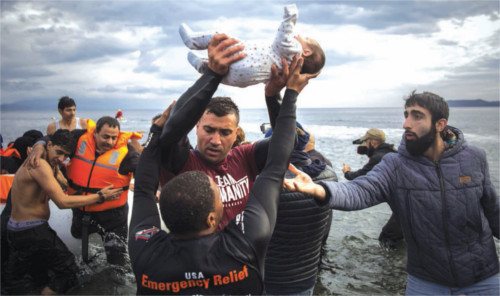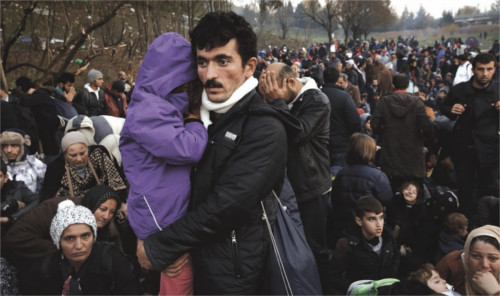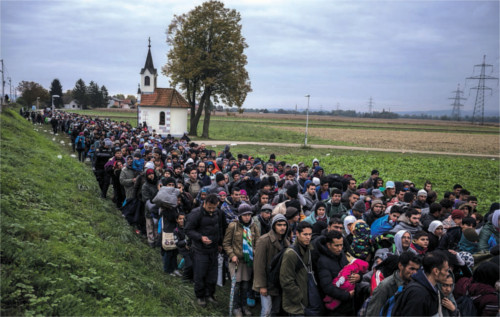By Deborah Amos

Volunteers assist refugees who traveled in a dinghy from Turkey to the Greek island of Lesbos in November. Santi Palacios/AP
In the great exodus of our time, the migrants paused for movie night in the farming village of Idomeni on the border between Greece and Macedonia. The bright lights of a projector, donated by local aid volunteers, cut through the dark winter gloom for a screening of Wall-E, featuring a child-like robot trapped in a dystopian world.
The Disney feature was a way to distract the children from their miserable surroundings for a few hours, but the adults knew all too well about dystopia. Idomeni had become another misery hotspot for refugees and migrants alike. It‘s a speck of a town grown to a dateline, with more than 12,000 inhabitants at one point last winter. The desperate and displaced had gathered at the latest gateway to Europe only to find that the door to the so-called “Balkan route” had slammed shut after the European Union and Turkey hammered out an agreement to stem the flow in marathon talks in Brussels.
It was five years ago in March that peaceful protests in Syria transformed into a brutal civil war and the first wave of refugees crossed the borders into neighboring Turkey, Lebanon and Jordan. I‘ve witnessed every phase of the exodus, as the trickle became a torrent.
The harrowing scenes in the crowded camps on the Greek border are the latest chapter of the Syrian catastrophe, a symbol of another cruel failure of the international community. In Syria, proxy powers and regional competition take precedence over the suffering of so many civilians. The story has been a challenge to cover since the first protests in a Syrian farm town in March 2011. Reporting on the refugees‘ journey from Turkey to Greece and onward has been especially daunting. One refugee is a tragedy; two becomes a statistic. How to convey the calamity of this unprecedented movement of human beings? How to portray the motivation and the circumstances that would compel a family to walk the back lanes and forests of Europe in the freezing cold?
For every Syrian refugee, the choice is wrenching. Those who decide to pay smugglers for a seat on an unstable raft for a ride across the fatal waters of the Aegean Sea have chosen life over certain death in a war zone. They are convinced the only way to save their children is to risk their lives one more time on the open sea. In many ways, the journey is Darwinian – a real-life Hunger Games with a tangible prize: a future. The grand prize, on offer via German Prime Minister Angela Merkel‘s open door policy, is a job, free education, a stable government, and perhaps even a European passport.
This summer I watched in southern Turkey as the exodus started to build. Most Syrians didn‘t want to leave their country. They clung to their homeland as long as possible, even as it crumbled around them. Turkey was seen as a temporary refuge; a place to wait out the war. But by the summer of 2015, many Syrians concluded the wait could last for a generation.

Iraqi Oman Saman holds one of his four children as he waits in October with other refugees in a soggy field in Slovenia near the Austrian border for European officials to determine his fate. Carolyn Cole/Los Angeles Times
As the summer weather reduced the risk of a sea crossing in flimsy boats, the exodus to Europe began as soon as the school year ended. “A lot of this is about education,” explained Rae McGrath, Mercy Corps‘ country director for Turkey and northern Syria. “The one thing that all (Syrian) parents say, and it‘s always the same – education,” he added, citing one reason that so many had decided to abandon Turkey for the dangerous trip.
Turkey has been very welcoming to Syrians, but the language barrier meant many refugee children had not been in school for years. Syria‘s exiled professional class had organized a private school system along the border, but in the summer of 2015 more than a dozen Syrian schools in Turkey that offered courses in Arabic were closing because private donations had dried up.
Surprisingly, a second wave of migrants to Europe came from pro-government areas inside Syria. “Mostly, what I‘ve seen is people coming directly from regime areas to Turkey to get out,‘ explained Bassam Al-Kuwatli, a Canadian-Syrian who moved to Turkish border town of Gaziantep to help the opposition. “It‘s pro-regime and anti-regime.”
The best and the brightest joined the wave. International aid agencies that deliver food aid and medicine into northern Syria lost their most qualified local staff, doctors and dentists, to the pull of Europe, where there is a path to re-licensing to open practices again.
In July, I met 29-year-old Syrian activist Hiba Ezzideen in Gaziantep. Her resumé was typical. A college English professor before the war, Ezzideen first joined the protests against Syrian President Bashar al Assad in 2011 because she believed that the popular demonstrations could transform her country.

Migrants escorted by riot police walk in October to a camp outside Dubova, Slovenia, to register as refugees. Sergey Ponomarev/
The New York Times
Ezzideen had accomplished more than most. She founded the first women‘s center in Syria‘s northwestern city of Idlib after rebels liberated the surrounding countryside. She continued her work when radical Islamists took control of the provincial capital of Idlib. She organized a network of journalists to challenge the growing power of the militants. She fled to Gaziantep when militants threatened to kill her, but continued to support her network of reporters inside Idlib from Turkey.
This dynamic activist seemed committed to sticking it out to shape Syria‘s future when we talked on a quiet summer day near the Syrian border. Yet a few weeks later her resolve had collapsed. “Suddenly, I felt we are doing nothing serious for the people,” Ezzideen explained via Skype when I reached her in a refugee camp on the German border a few weeks after we met on the Turkish border. “It was one night. I have to make a decision. I didn‘t sleep. Is there a future in Turkey? And I said ‘no.‘“
After posting her decision on Facebook, she set off alone from southern Turkey for a journey of more than 1,000 miles. She paid for a seat on an overcrowded raft, rode in a sealed truck, walked through a forest, slept on the street and in a jail cell to reach northern Europe. Ezzideen had weighed all the risks. She consulted Facebook and Internet forums that explained every step along the way, listing the ferry schedules, cheap hotels and the best answers to border guard interrogations to ensure a smooth passage.
Still, the harrowing journey was filled with unexpected dangers. Ezzideen survived two failed attempts to escape by sea. Smugglers stopped one crowded boat at gunpoint to steal the engine in the dead of night, forcing passengers to paddle back to the Turkish shore and try again. On her second attempt, an overcrowded wooden ferry began to sink after five hours lost in the water. “The Greek coast guard rescued us. They were yelling at us, ‘Why do you keep coming?’” she recalled.
The landing on the Greek island was the beginning of a 20-day odyssey through the “Balkan route.” Her traveling companions included a wounded rebel commander and a regime supporter from Damascus. Now, they were all in the same boat. “In my camp, more than half of the people are (regime) supporters,” Ezzideen said of the refugee center where she was staying in March. “Really – it‘s strange.” She asked that her exact location not be disclosed. But I can see her new post on LinkedIn. It‘s Hiba, without a head scarf, in full make up, a dynamic young woman who will find her future in Europe.
As of mid-March, the route she took to escape Syria was closed. A string of Balkan nations had shut their borders tight, leaving more than 30,000 migrants stranded in Greece.
Deborah Amos covers the Middle East for National Public Radio. She is a member of the Board of Governors of the OPC and author of the book Eclipse of the Sunnis. Awards include the George Polk and DuPont-Columbia, but she is most proud of recent teaching fellowships, mentoring journalism students at SUNY, Columbia and Princeton.
